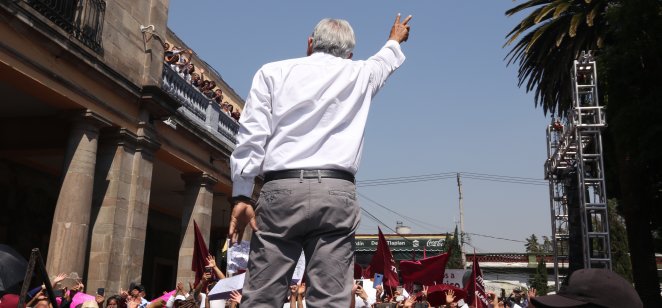[ad_1]

Mexico’s increasingly liquid peso (MXN) gained 0.3% Thursday, despite more momentum towards the US dollar with the release of the US Federal Reserve’s March minutes. The Fed said it was “prepared to use its full range of tools to achieve its maximum employment and price stability goals”.
Populist President Andrés Manuel López Obrador (AMLO) asks voters this Sunday if he should finish his six-year election term. The referendum, or voter question, is rhetorical: Obrador is already in office.
Given Obrador’s popularity, it is likely he should cruise through, even if the referendum turns out to be invalid – Mexican law demands 40% of voters take part.
“I don’t expect much from the recall referendum. How S&P futures trade during the Asian session on Monday will be far more important for where USD/MXN opens up next week,” Christian Lawrence, senior cross-asset strategist at Rabobank told Capital.com.
“The outcome of the recall referendum is all but assured, although I highly doubt there will be the 40% turnout needed for the decision to be legally binding.”
Balance of risk
This morning USD/MXN was trading at 20.1574, with the peso trading at a substantially better level than the 21.35 seen a month ago. The peso’s resilience is supported by the strong chance of more interest rate rises from Banxico, the country’s central bank.
Mexico’s central bank policymakers lifted rates by 50 basis points to 6.50% in late March as inflation reared. This leaves the main interest rate at its highest since early 2020.
Andres Abadia, chief Latin American economist at Pantheon Macroeconomics, expects more tightening ahead – to at least 8.25% by the end of 2022.
He thinks a more hawkish-than-expected Banxico Board (the 24 March announcement was unanimous) plus a relatively resilient economy in the first quarter of 2022, despite Omicron, have all got behind MXN.
Weekend showboat
Meanwhile, the peso has overcome downside forces, says Abadia, which includes Obrador’s weekend referendum, thought to have cost as much as $80m (£61m).
“That said, we believe that MXN drivers are less supportive at this stage, given the strong rally this year, the overweight investor positioning, which increases the MXN’s sensitivity to risk aversion spikes, and the potentially large risks represented by a stronger-than- expected Fed tightening cycle.”
Abadia believes Mexico’s high interest rates and improved domestic economic outlook should limit the chances of any potential MXN sell-off.
Stagflation risk prowls
Banxico is still staring down substantial stagflation risk, adds Christian Lawrence, at Rabobank. Despite nominal wage growth, real wage growth is what matters for households and this remains negative.
For now though, Lawrence says rate differentials and more importantly, risk appetite, are the key drivers of USD/MXN. “If AMLO were to use this as an argument for changing the rules to run for a second term, then that would be market moving – but that is another story.”
FX backing commodities and rate lifts
The Rabobank analyst believes USD/MXN will continue to trade through the 20.50-21.50 range for the rest of 2022, despite the Russian invasion of Ukraine.
FX markets are still undergoing a major relationship shift with price action, so far in 2022, backing commodity producers and rate hikers.
“In this respect, MXN has lagged. Despite producing oil, MXN does not trade as an oil currency,” Lawrence wrote, separately, in a briefing note.
What is your sentiment on USD/MXN?
Vote to see Traders sentiment!
“The economy is more geared to production of intermediary goods than it is to exporting oil, and historically when we see a close correlation between MXN and oil, it is usually about the third variable of risk.
“As it stands,” he goes on, “oil is, of course, not trading in line with risk and is instead trading on the back of supply risks as Russia is cut off and an inflation hedge as investors seek to buy commodities as a hedge for their portfolios.”
- While MXN remains the most attractive carry [FX trading strategy] currency globally says Rabobank, the rise of rates across the LatAm region has shifted currency flows.
- Since the start of 2022, MXN has underperformed most of its regional peers.
- But Banxico is starting to play catch up – and MXN could outperform Brazil’s real (BRL) by year-end.
CPI up again
Yesterday the Mexican government’s INEGI statistics agency confirmed that consumer price index (CPI) rose to 7.45% in March – well above the central bank’s 3% target, underpinning March’s central bank rate rise.
The month-on–month increase was bigger than the 0.8% gain last year and the month’s biggest rise since 1998 warned Pantheon Macroeconomics’ Abadia, driven by both non-core and core metrics.
“The latter [core] rose by 0.7% unadjusted, contributing 0.53 percentage points to the month-on-month headline increase. Goods prices climbed by 0.9% month-on-month, mainly driven by increased processed food and tobacco prices.
“Higher raw material prices, the reopening, and the MXN sell-off during the first weeks of the month contributed to this acceleration.”
Crass timing
The Mexican president caused financial market uproar when he went public with the 24 March Banxico rate rise before the official announcement.
The shock news immediately fuelled independence questions: how independent was Banxico? Who decides monetary policy?
It is likely the controversy over Obrador’s presidency will continue through 2022. The weekend ratification vote comes before other elections across six states, all represented by opposition parties.
Given Obrador’s fiscal restraint and severe cutbacks in public administration, the country’s infrastructure has deteriorated and government services continue to suffer says Rice University’s Baker Institute for Public Policy.
“Public demands for attention to these issues will grow in 2022. In response, the president will find refuge in the military, as he has in the past.”
Read more:
[ad_2]
Source link




/cloudfront-us-east-2.images.arcpublishing.com/reuters/ARHZ5EW6L5LVVIRTRRXQNLFDWA.jpg)










